Ein Gedi Nature Reserve – Visitors Guide (Map, Trails and More)
Ein Gedi Nature Reserve by the Dead Sea offers trails through nature, history, archaeology, and wildlife.
Table of Contents
- 1 Map
- 2 Trails
- 3 Opening Hours
- 4 Entrance Fee
- 5 What is the Meaning of Ein Gedi?
- 6 Weather
- 7 Streams and Springs
- 8 David Stream
- 9 Ein Gedi in the Bible
- 10 Chalcolithic Temple
- 11 Ein Gedi Ascent
- 12 Ein Gedi Spring
- 13 Ein Gedi Ancient Synagogue
- 14 Wildlife (Animals)
- 15 Common Questions
- 16 Archaeology and History
- 17 Biblical Persimmon – Shemen Afarsimon
- 18 Summary
Map
Ein Gedi Nature Reserve is near the Dead Sea and Kibbutz Ein Gedi.
Directions for drivers: Link to Waze and Link to Google Maps
Directions for public transport: Link to Moovit
Interactive map of the area:
And here is the hiking map of this nature reserve.
Note: you can click on the trail map to enlarge it.
Trails
As you can see from the trail map above, there are several parking lots and many starting/ending points. You can combine the trails in at least a dozen different ways.
The brochure that you receive at the entrance suggests nine different trails. And I will list the most popular and our favorites.
| # | Entrance | Trail | Level | Start Hike no later than | Hiking Time (hours) | Distance (km) | Total climb and descent (meters) |
|---|---|---|---|---|---|---|---|
| 1 | Synagogue Parking | The Ancient Synagogue | Easy | 15:30 | 0.5 | 0.2 | 0 |
| 2 | Main Entrance | Wadi David and David Fall | Easy | 15:00 | 1 | 1.6 | 160 |
| 3 | Main Entrance | David Fall, Shulamit Spring, Dodim Cave, and Ein Gedi Spring | Medium | 13:30 | 3 – 4 | 3.6 | 416 |
| 4 | Wadi Arugot Entrance | The Hidden Fall | Medium | 14:00 | 2 – 3 | 4.4 | 258 |
| 5 | Wadi Arugot Entrance | The Hidden Falls and the Upper Pools | Hard | 12:00 | 4 – 5 | 6.85 | 350 |
| 6 | Main Entrance | David Fall, Shulamit Spring, Chalcolithic Temple, Ein Gedi Spring, Tel Goren, and the Ancient Synagogue | Medium | 13:00 | On average, it takes us 3.5 hours (at a moderate pace) | 4.4 | 420 |
| 7 | Wadi Arugot Entrance | The lower pools | Easy | 14:00 | 1 – 2 (depending on the stops at the pools) | 1.7 | 50 |
Notes:
- The latest start hike time is according to the winter clock. You can add one hour during the summer.
- Trail #2 is by far the most popular one. Schools and many tour guides usually choose it. Thus, if this is your first time, use it or incorporate it (like trail #3 or #6).
- #4 and #5 are also known as the short and long Wadi Arugot hikes.
- #6 and #7 are examples of hikes we did on our recent visits.
Also, remember that you have to start early to hike the longer trails. Here is the time limitation sign that you can find near David Fall.

Directions
If you are arriving by car, enter “Ein Gedi Nature Reserve” into Waze or Google Maps, which will take you to the main parking lot. Furthermore, there is a free parking lot near the entrance. You can also use the links above the interactive map.
And if you are using public transport, you can take bus #444 from Jerusalem to Eilat and exit at Nahal David Field School. Here is the updated link to Moovit. Enter your starting point, and you will get the updated directions.
Opening Hours
Sunday – Thursday and Saturday: 8:00 – 17:00 (16:00 in winter).
Friday: 8:00 – 16:00 (15:00 in winter).
On holiday eves, usually 8:00 – 13:00.
Note: Since the pandemic, the Israel Nature and Parks Authority has started limiting the number of people in each park. Thus, reservations are recommended through the official site (you can find the link below).
You can enter Wadi Arugot only before 14:00.
Note: for additional information about Arugot, see Wadi Arugot.
Entrance Fee
Adult – 28 NIS, child – 14 NIS, and student – 24 NIS. Free for National Parks annual subscribers.
If you visit several National Parks, consider purchasing a combo ticket. For additional information, see National Parks and Nature Reserves.
If you visit only the ancient synagogue, the entrance fee will be 14 NIS per adult, 7 NIS per child, and 12 NIS per student.
Note: Opening hours and ticket prices were updated in April 2024. In any case, recheck the official site before visiting. You can also make reservations at the official site.
What is the Meaning of Ein Gedi?
The name Ein Gedi consists of two words, and the literal translation from Hebrew means “the spring of the young goat.” That is, according to modern Hebrew. But in Biblical Hebrew, the word “GDI” referred to the baby of any animal.
Today, when you walk at En Gedi, you will see Nubian Ibexes drinking water from the spring. I guess our ancestors saw the same, hence the name.
Weather
Ein Gedi Nature Reserve is in the desert. So it is very hot there. Moreover, after the rain, there is a danger of floods. Hence, do not visit the Dead Sea area for several days after the last rain.
When to Visit Ein Gedi?
Due to the weather, the best season for a visit is anything besides Summer (and not after rain). Moreover, visit early in the day as it will get hot by noon. Also, if you plan to hike the longer tracks, you must come early.
And always take hats, sunscreen, and plenty of water.
Note: We prefer to visit in the winter or spring (depending on whether you plan to enter the water).
Streams and Springs
As you probably noticed in the previous section, most trails will go near water. After all, Ein Gedi is the largest Oasis in Israel.
At En Gedi, there are two streams. The main entrance is near David Stream, and the other entry is close to Arugot Stream.
There are two year-round streams in the nature reserve: David Stream (relatively short, draining an area of some 18 square kilometers) and the larger Arugot Stream (40 km in length, draining 200 square kilometers in Mt Hebron and the Judean Desert plateau). In addition, four small springs rise in the nature reserve: En David (in David Stream), En Arugot (in Arugot Stream), En Shlomit, and En Gedi spring on the hillside between the two streams. Their total output is around 3 million m3 per year, and the source of this water is the rainfall in the Judean Hills, which seeps into the groundwater and gushes up in the nature reserve area.
Note: unless stated otherwise, all quotes were taken from the official site.
Water, especially in the desert, is life. It also means human settlements. However, I will mention Archaeology and History towards the end of this guide.
I will now elaborate on trail #6.
David Stream
You can find a picnic area, restrooms, a small shop, and dog cages at the main entrance. Entrance with dogs is forbidden. Thus, there are cages where you can leave your dog at the entry. But since the enclosures are small, it is better not to bring your pet.

We encountered a herd of Nubian ibexes as we entered Ein Gedi Nature Reserve. However, we will not discuss wildlife at this point. We will discuss it later in the article when encountering a group of rock hyraxes. For now, I will only mention the En Gedi mineral water. You can find it in most Israeli supermarkets, and its logo, as you probably guessed, is a Nubian ibex.
Note: Another popular place in Israel where you can meet Nubian ibexes is Mitzpe Ramon.

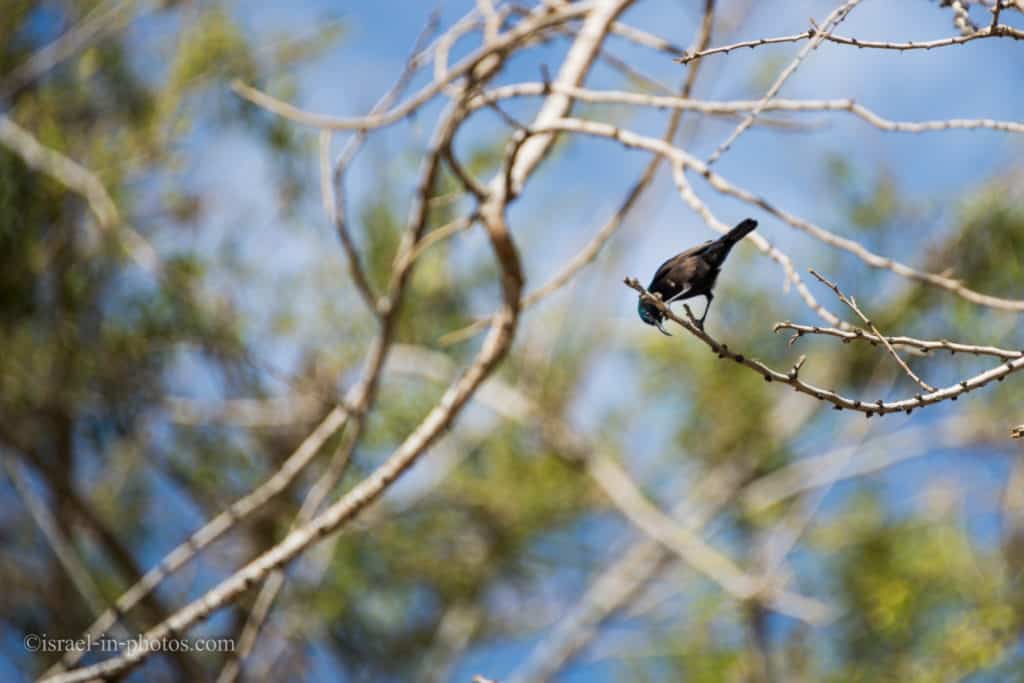
Accessibility
Parts of this park were made accessible. As you can see, the trail near the main entrance is wheelchair accessible.

According to the official website, here is the list of accessible parts:
- The main entrance to the site includes parking, the entrance area, a visitor service station, and an accessible restroom.
There is also a wheelchair-accessible trail along Nahal David Stream. The track is about half a kilometer long. - Parking near the ancient synagogue and walking through the archeological site are on a well-paved path.
Also, service animals are not permitted in the Ein Gedi Nature Reserve. Animals may be left in a cage at the reserve entrance for a visit.
Lower Waterfall
The accessible trail reaches the lower waterfall.
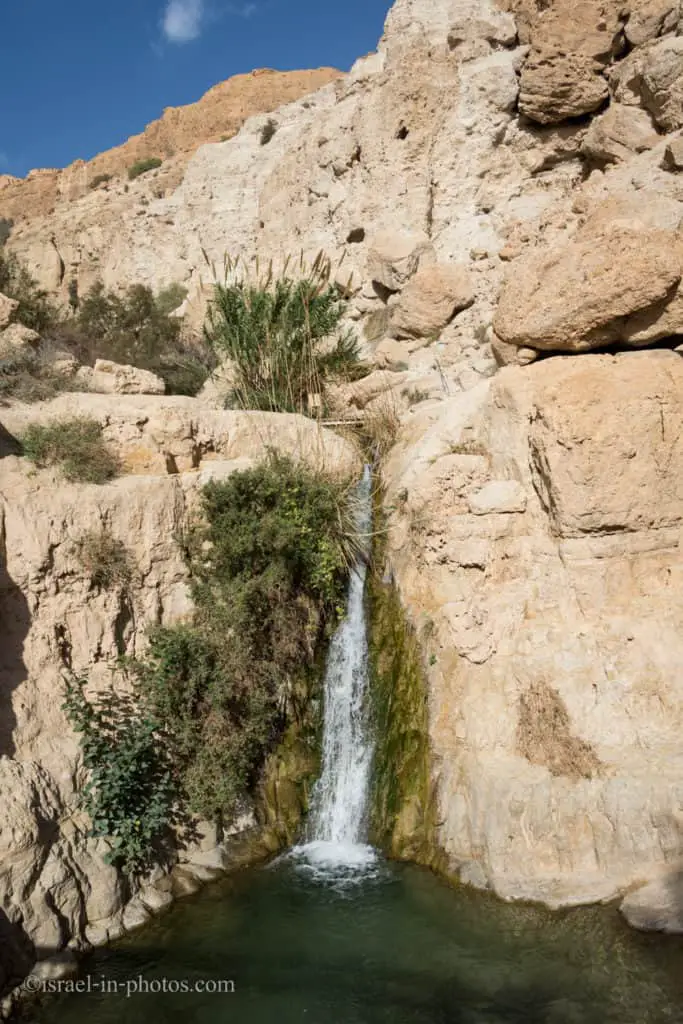
From the lower waterfall, we continued to hike along David’s stream.


Most of this trail includes climbing on rocky terrain, small pools, and slippery rocks. Thus either wear waterproof climbing shoes or water sandals or both. In any case, they should be comfortable and non-slip.

Ein Gedi in the Bible
The hike from the main entrance to David Waterfall takes about 40 minutes.
While we are at David’s waterfall, I want to talk about the name. David’s stream and waterfall are named after King David. When David fled from King Saul, he hid at En Gedi, one of the towns of the tribe of Judah.
But this is not the only time Ein Gedi is mentioned in the Bible. According to a simple search query I ran at BibleGateway, En Gedi has been mentioned six times.
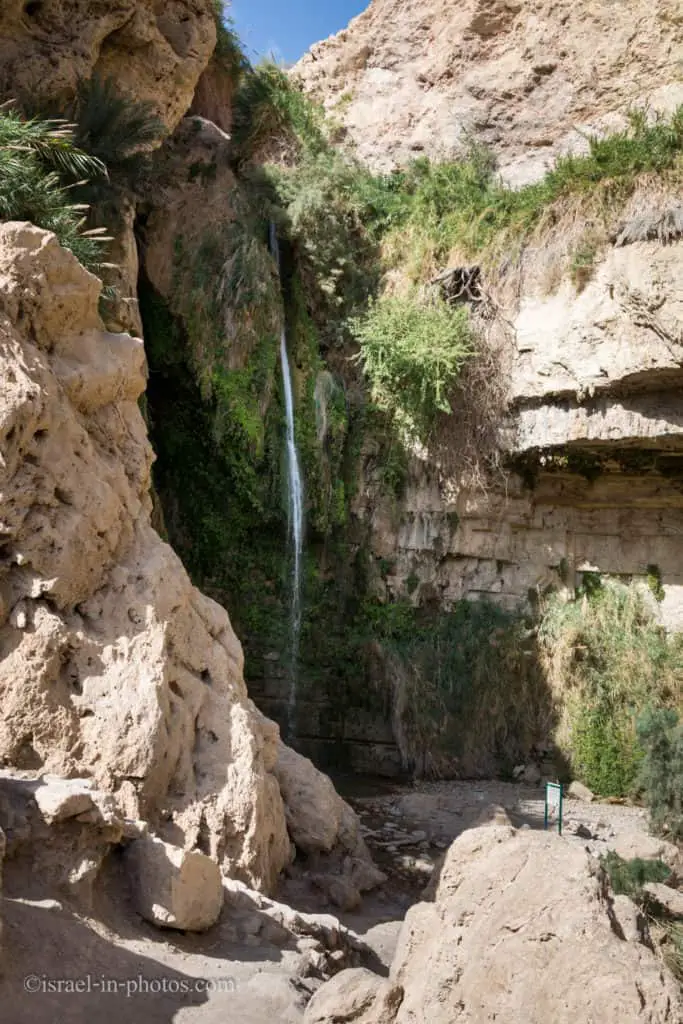
Joshua 15:62 (NIV):
Nibshan, the City of Salt and En Gedi—six towns and their villages.
1 Samuel 23:29 (NIV):
And David went up from there and lived in the strongholds of En Gedi.
1 Samuel 24:1 (NIV):
[ David Spares Saul’s Life ] After Saul returned from pursuing the Philistines, he was told, “David is in the Desert of En Gedi.”
You can find all the mentions at BibleGateway.
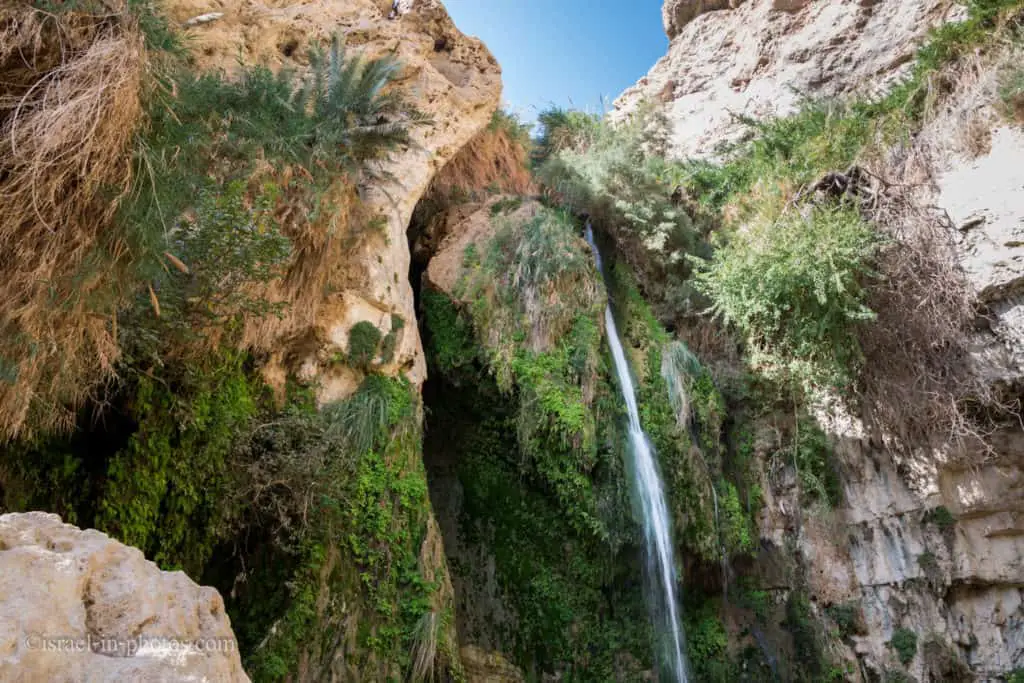
You can return to the main entrance from David Waterfall. This round route is probably the most popular trail among tourists. But we decided to take a longer hike and started climbing the hill towards Shulamit Spring.
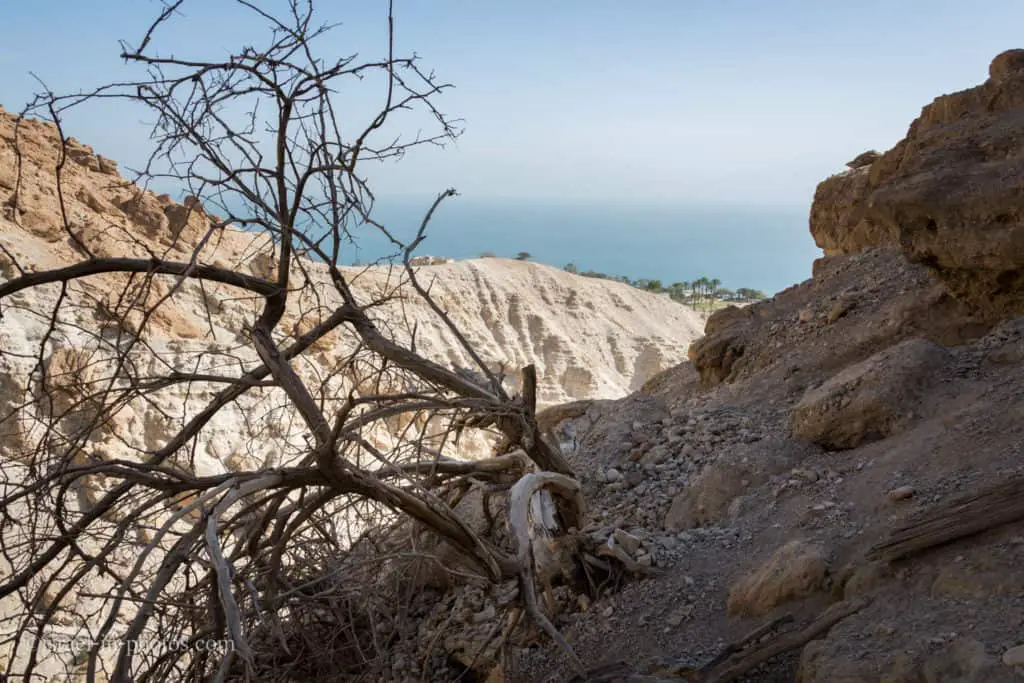
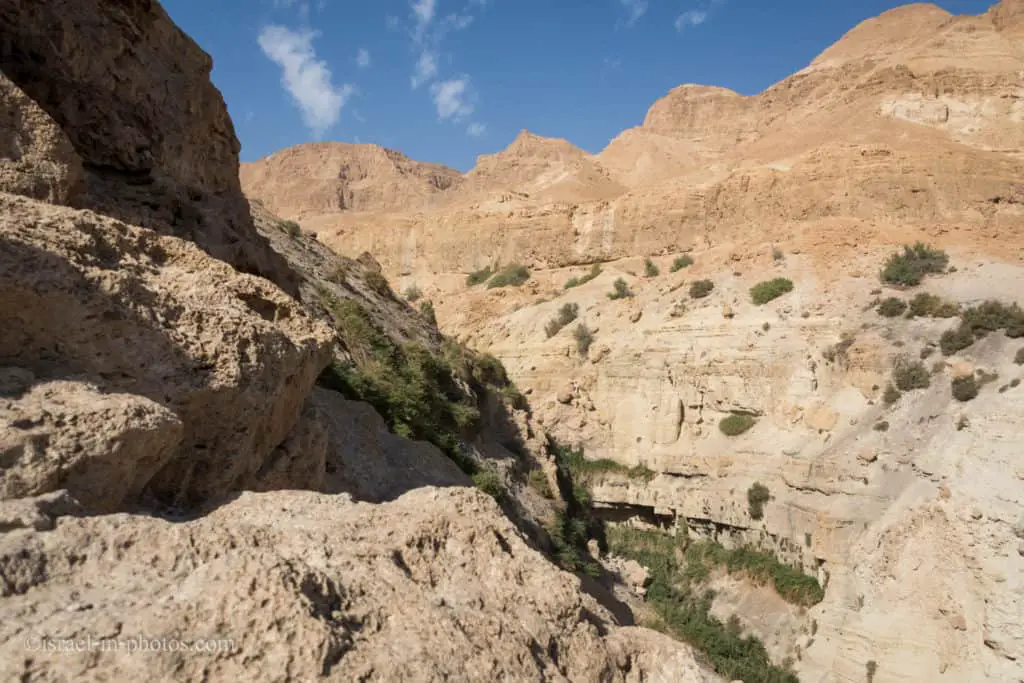
We decided to skip Dudim Cave since the hike would be too hard on my daughter. So we headed to the Chalcolithic Temple.

Chalcolithic Temple
The earliest remains discovered in Ein Gedi are from the Chalcolithic period (5,000 years ago). During this period, copper began to be used in Israel. A central shrine was erected at En Gedi that attracted pilgrims from a distance. The temple was constructed above the Ein Gedi spring in front of the Dead Sea and the Moab Mountains. There was a ritual associated with water. In a cave at Mishmar Stream, 429 worship vessels made of copper and ivory were found. They are probably related to this temple. And today, they are on display at the Israel Museum.
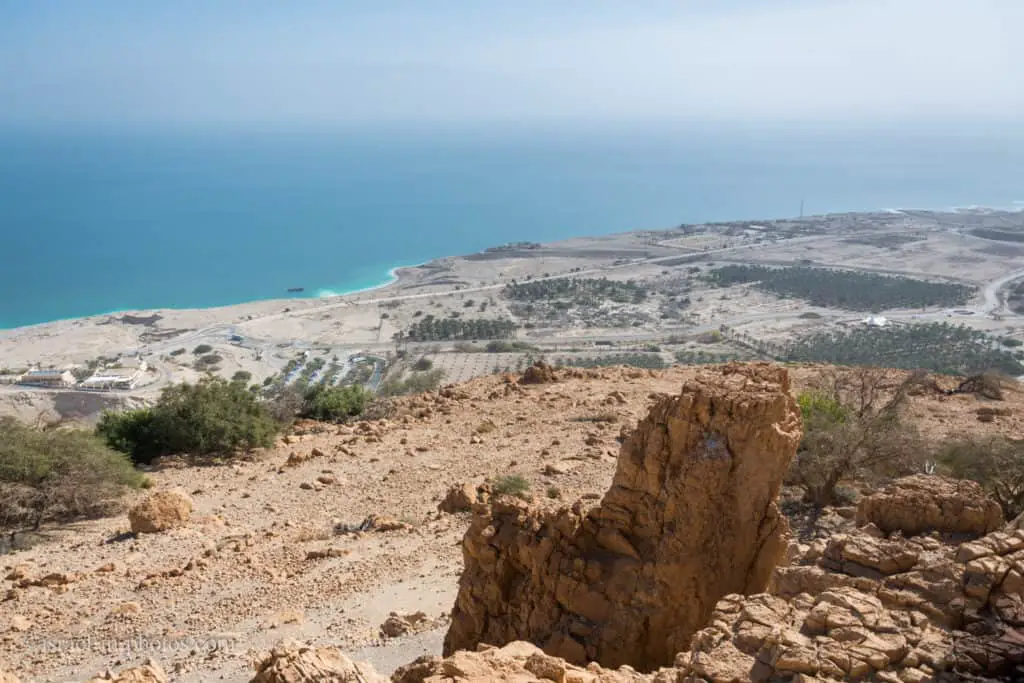
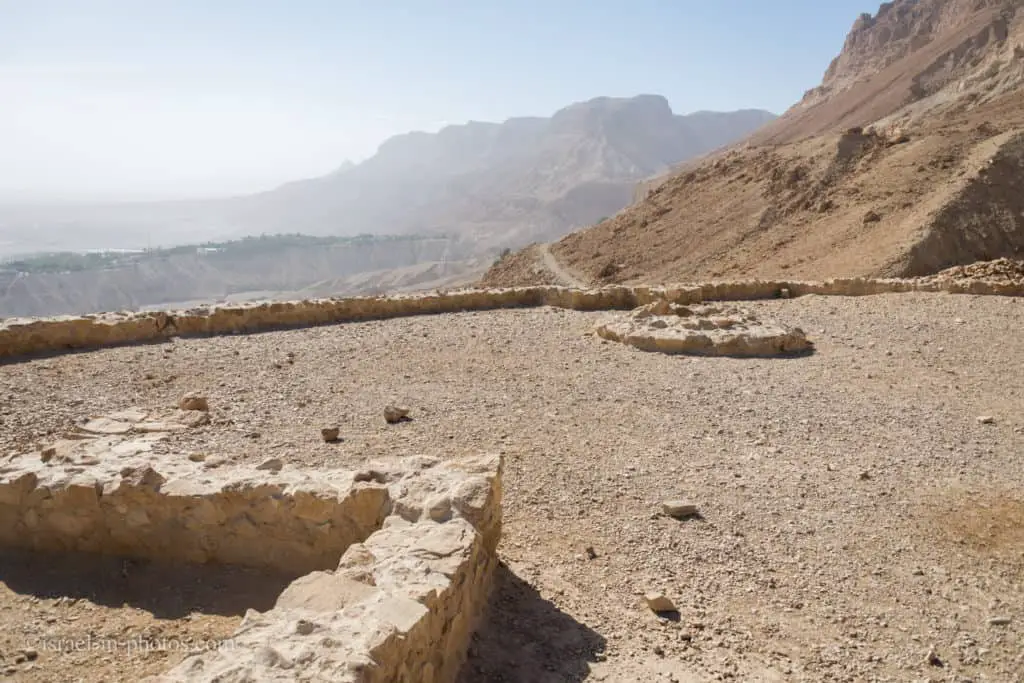
From the Chalcolithic Temple, we started to descend towards Ein Gedi Spring.
Ein Gedi Ascent
Along with Ein Gedi Ascent, the black trail towards En Gedi Lookout leads to the top of that mountain.
En Gedi Ascent – 5 steep trails climbing up from the En Gedi oasis to the Judean Desert plateau: Mt Yishay Ascent, En Gedi Ascent (an ancient path that some consider being the Tsits Ascent mentioned in II Chronicles 20:16), the Bney Ha’Moshavim Ascent, the Essene Ascent (an ancient Roman path), and Tsruya Ascent. All are for experienced hikers only and not for hiking during the summer or on sweltering days.
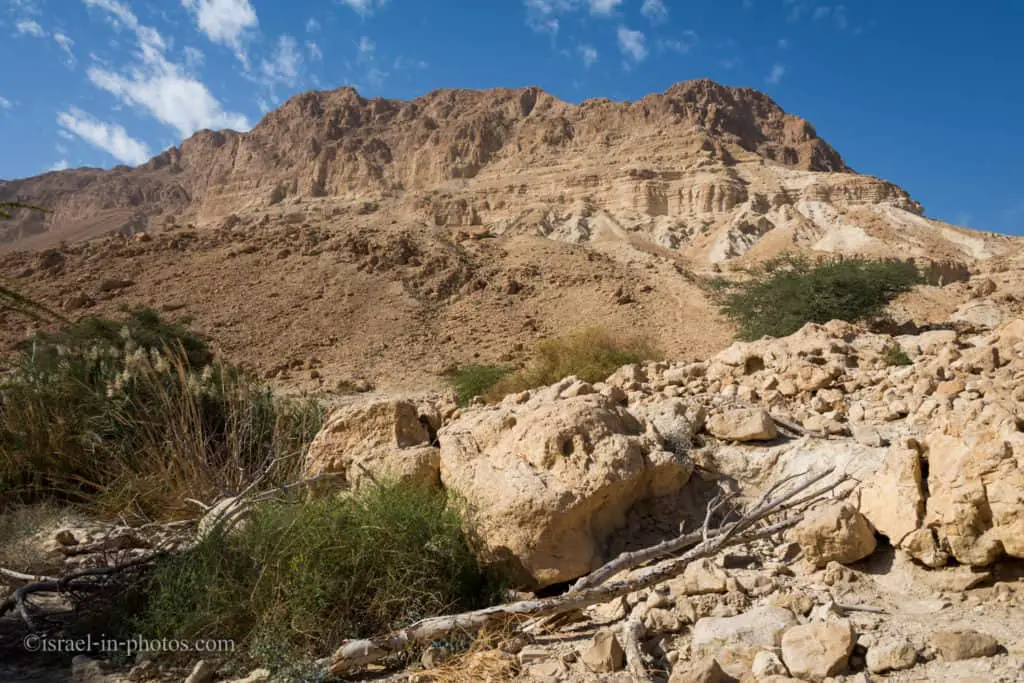
Ein Gedi Spring
En Gedi Spring – rises in the mountainside and sustains abundant vegetation. By the spring are the remains of an ancient flour mill.

As mentioned above, Ein Gedi mineral water can be found in most supermarkets. Thus, you will not find a big spring with lots of water at En Gedi Spring. Instead, you will see plastic pipes, a small wading pool, and some vegetation near the pool.

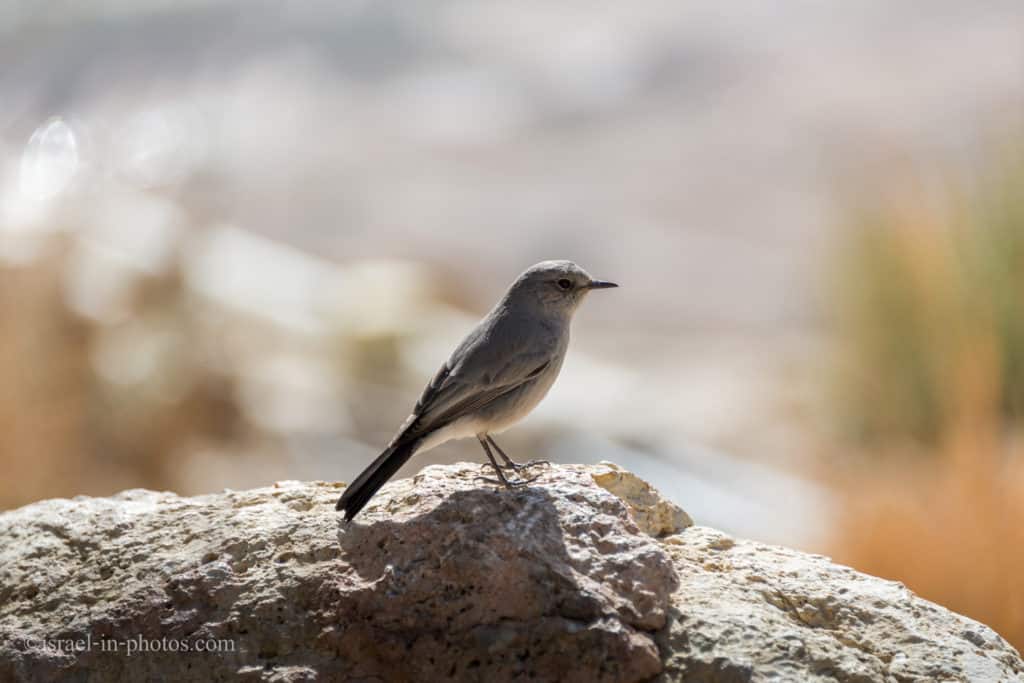
After several minutes, we saw the remains of a flour mill.
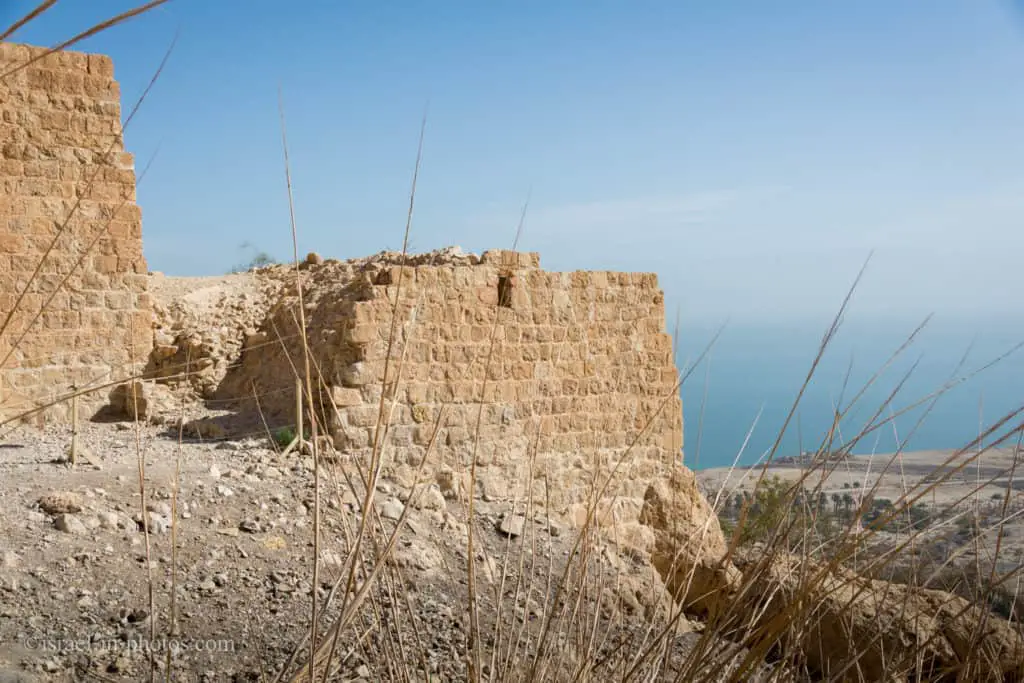
This chimney-type flour mill was built during the Mamluk period (13 – 14 centuries CE).
We continued our descent along the black trail toward ancient En Gedi.

Ein Gedi Ancient Synagogue
The Ancient Synagogue path is the first trail I mentioned in the “Trails” section. It is a small national park, and you can visit it separately. There are nearby parking and restrooms. As per the entrance fee, you can find it above.
The site includes the synagogue, the nearby street, and several houses around it. It also contains the remains of the ancient Jewish community dating back to the Second Temple period.
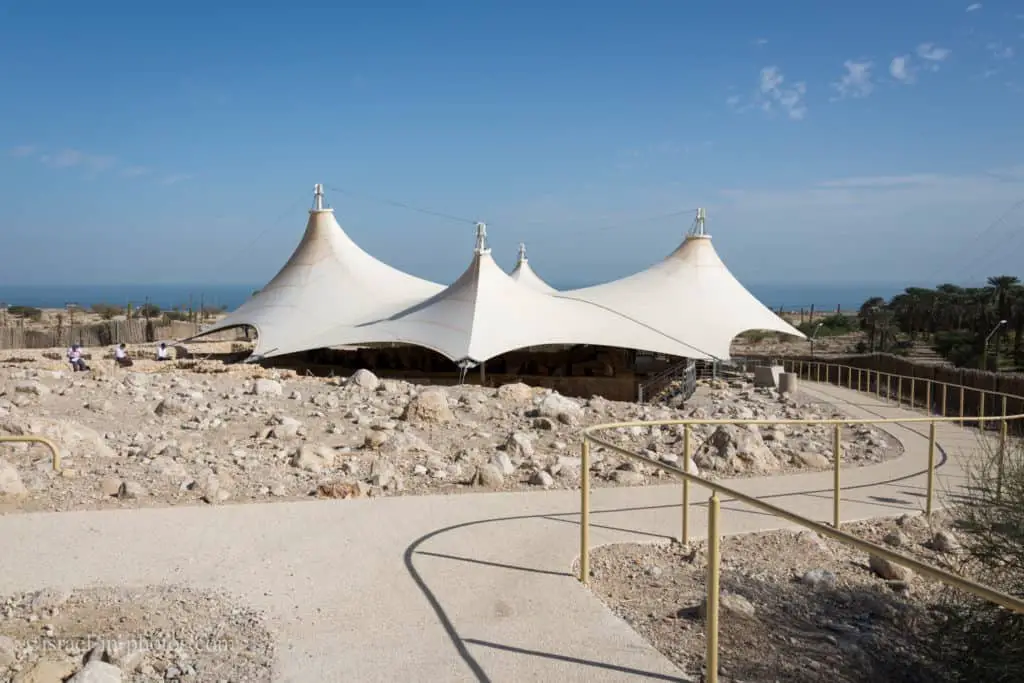
Ancient Ein Gedi – Archaeology and History
The ancient Jewish settlement in Ein Gedi, on the site of the synagogue and its surroundings, is dated to the third to sixth centuries CE. The researchers know this period as the late Roman and Byzantine periods or the Mishnah and Talmudic eras.
Beneath the remains of the settlement from the Mishnah and Talmudic periods, a Jewish settlement from the end of the Second Temple era (Early Roman period) was found.
According to the testimony of Eusebius (historian of Christianity and the bishop of Caesarea Maritima at about 314 AD), there was an “extensive Jewish village” in the place.
From ancient sources, we know that En Gedi residents grew dates and Biblical persimmons (for more info, see the Biblical Persimmon section above). They created a precious perfume from the Biblical persimmon tree, which was in great demand in the past. In addition, the agricultural terraces to the west are evidence of the residents’ agricultural occupation.
The remains of the settlement, which were exposed, include streets, homes, and a synagogue. Those who served there may have used the houses near the synagogue. And maybe the houses were used as guest houses (the synagogue structure was fully exposed, and streets and houses were partially revealed).
The synagogue was built at the beginning of the third century CE. The structure has a Trapeze shape. The northern wall, facing Jerusalem, had two openings. Its floor was made of white and black mosaic stones. The holy ark was a movable box.
At the beginning of the fourth century CE, changes were made to the synagogue structure (the mosaic was only repaired). The central doorway was blocked in the northern wall and became the niche where the Holy Ark stood. In addition, the building area was divided using columns to the main hall and two elongated spaces to the south and east.
The synagogue was rebuilt in the middle of the fifth century CE (the building we see today). It included a hall bounded by three elongated spaces. The Holy Arc was placed near the northern wall, with a rectangular stage in front of him. Also, the mosaic floor was installed in the hall, and a dedication inscription was in the western space.
The Jewish settlement and synagogue were destroyed in the fire. A bundle of coins wrapped in cloth was discovered in the courtyard of a house near the synagogue. Those coins are from the days of Emperor Justinian. During the beginning of Emperor Justinian’s rule, Jews suffered from persecution. In light of these facts, scientists conclude that the settlement and the synagogue were destroyed by that wave of persecution at around 530 CE.
Source: translated from the official booklet.
Mosaics at the Ancient Synagogue
The mosaic at the central hall of the synagogue:


As you can see in the next shot, there are numbers on-site, and the booklet you receive at the entrance explains each one.
Number #8 is where the Holy Ark once stood.
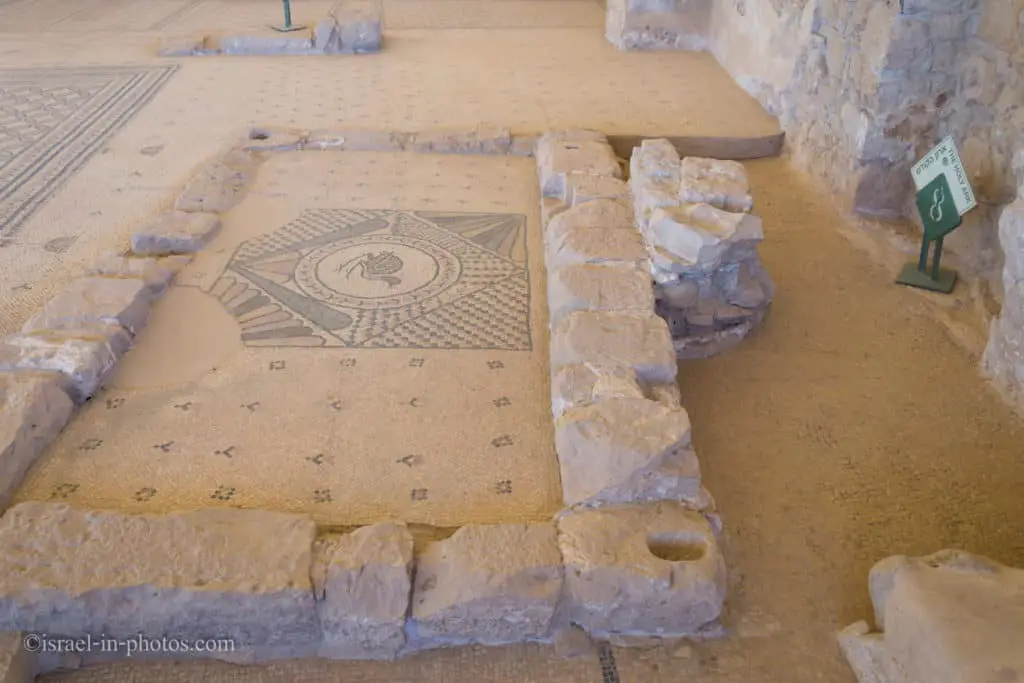
Near the Torah Ark, the floor is decorated with three small menorahs.

Here is a broader view of the synagogue’s mosaic floor. And you can also see part of the inscription.
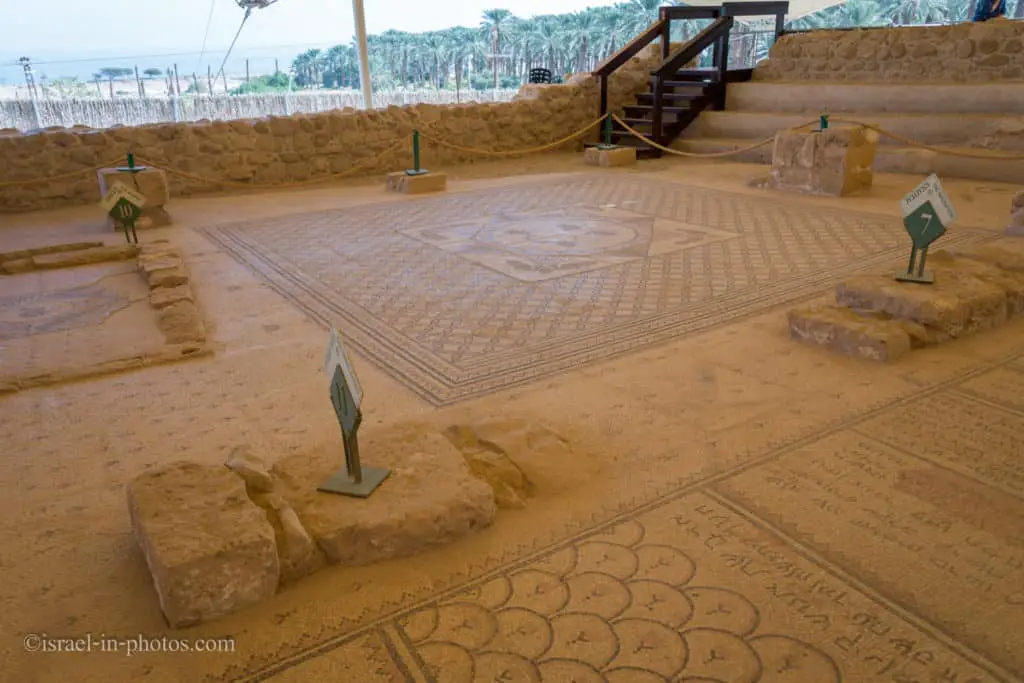
The inscription is divided into four blocks with eighteen lines in total. The fifth part, consisting of three rows, was added later when the synagogue was fixed.
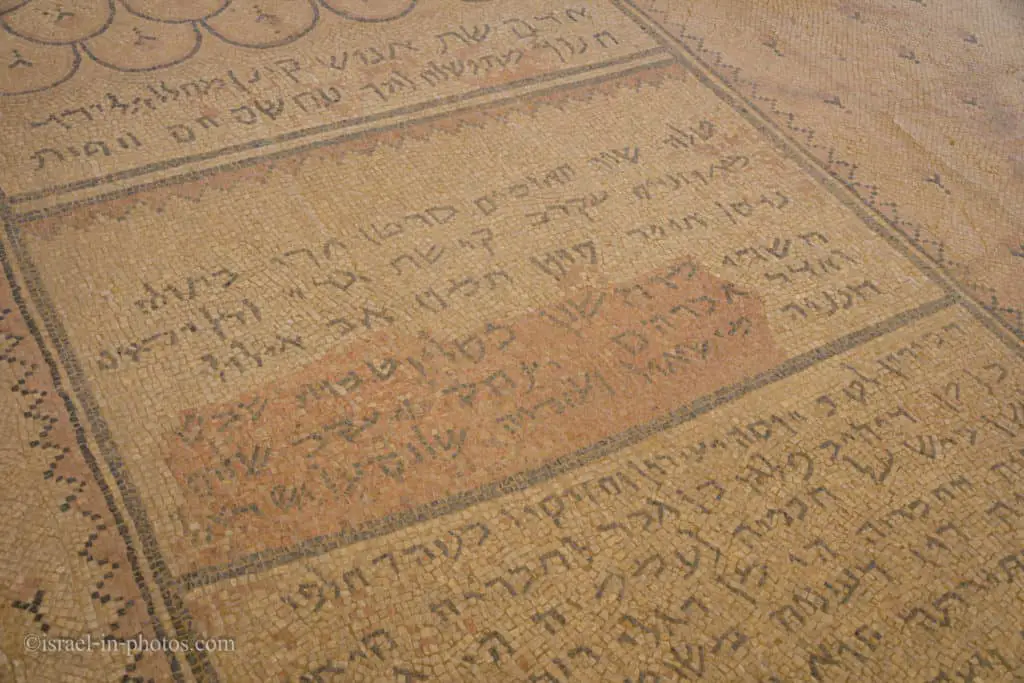
Wildlife (Animals)
So far, we have seen Nubian ibexes and several species of birds. But in my previous visits, I remembered seeing rock hyraxes, and I was a little disappointed that we had not seen them. But we heard a noise as we walked from the Ein Gedi ancient synagogue towards the main entrance. It was coming from the trees by the road. When we looked closely at the trees, we saw dozens of rock hyraxes on one tree and dozens of Tristram’s starlings on another.
Note: Check out Zoos and Aquariums in Israel for additional information about animals and wildlife.
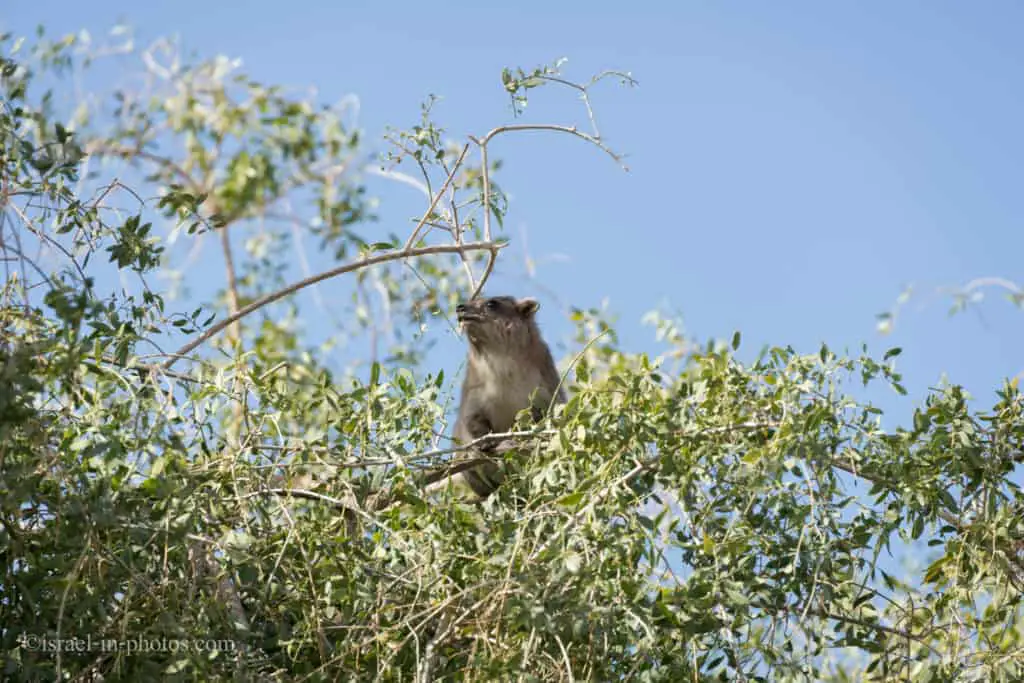

Note: you can also see rock hyraxes at Rosh HaNikra.
The Nubian ibex (Capra nubiana), which also stars in Nature and Parks Authority emblem, is adapted to living in craggy and rocky areas. The reserve is home to one of the largest herds of ibex in the country. Also very noticeable here, in addition to the ibex, is the rock hyrax (Procavia capensis).
Other mammals, such as foxes, wolves, and bats, are active at night, and 16 species of bats have been documented in reserve. Birds of prey such as the vulture (Gyps) nest in the cliffs. A widespread bird is Tristram’s starling (Onychognathus tristramii) – a medium-sized member of the starling family, recognizable by its black color and the orange patches on its wings. It is named for Henry Baker Tristram, the British priest, and zoologist who discovered this species. Also noteworthy are the fan-tailed raven (Corvus rhipidurus), the Blackstart (Cercomela melanura), and the sand partridge (Ammoperdix heyi).
Among the reptiles is a rare and poisonous snake that is hard to meet – the Israeli burrowing asp (Atractaspis engaddensis). Other snakes living in the area are the Echis (Echis) and the braid snake (Coluber rhodorachis). The abundance of water in the nature reserve also supports populations of marsh frogs (Pelophylax ridibundus), river crabs (Potamon potamios), gastropods such as the melanopsis (Melanopsis praemorsa), and dragonflies (Anisoptera). Among the insects living in reserve, it is worth mentioning the weaver ant (Polyrhachis simplex), which builds nesting colonies in the rocks along Arugot Stream.
Common Questions
David went to Ein Gedi to hide from King Saul. According to 1 Samuel 24:1, David Spared Saul’s Life after finding him unarmed. Afterward, they reconciled, and Saul recognized David as his successor.
Yes, En Gedi Beach is closed due to sinkholes.
You can either drive there or take a bus. For additional info, check out the directions section.
Ein Gedi consists of two words, and the literal translation from Biblical Hebrew means “the spring of the baby animal.”
Depending on the spelling, Ein can mean spring or no (in the sense of none left).
Ein Gedi is about 80 km from Jerusalem. Driving there will take approximately one and a half hours, depending on traffic.
Ein Gedi Nature Reserve is open. It is best to reserve places in advance.
Yes, Ein Gedi is open on Shabbat. See the complete opening hours at the beginning of this guide.
Ein Gedi is a historical place with stunning nature and the largest Oasis in Israel. Thus, various animals visit En Gedi (see the wildlife section above).
Yes. We visited Ein Gedi many times and never had any fears. Moreover, I do not remember any terrorist attack at Ein Gedi.
The literal translation from Hebrew means “the spring of the young goat.” That is, according to modern Hebrew. But in Biblical Hebrew, the word “GDI” referred to the baby of any animal.
Archaeology and History
The abundance of water at En Gedi has made human settlement possible since early times, especially settlements that engaged in growing crops based on irrigation systems. In the past, the area irrigated by spring water was some 1,100 dunams, as compared with only 500 dunams today that is cultivated by Kibbutz En Gedi using modern methods.
The most well-known ancient crop grown at En Gedi was the Biblical persimmon, Commiphora gileadensis, an ancient fragrance plant known as Bossem (not to be confused with the fruit known as persimmon today), which gained a wide reputation. Another plant that stood out here was the henna plant, mentioned in Song of Songs: “My beloved is to me a cluster of henna blossoms from the vineyards of En Gedi”
Chalcolithic Period
The first settlement at En Gedi appears to have been in the Chalcolithic period, some 5,000 years ago. At this time, there was a major temple here, attracting pilgrims from far and wide. No contemporaneous remains of the permanent settlement were found around the temple. Still, it is estimated that the trove of copper vessels from this period found in the Treasure Cave in Mishmar Stream belonged to those using the temple.
Biblical Times
En Gedi is mentioned several times in the Bible. It is one of the towns of the tribe of Judah in the desert and is where David concealed himself when he fled from King Saul in around 1000 BCE (after whom the David Stream is named). The archaeological documentation of the Jewish settlement dates to a later period, the 7th century BCE. The Jewish settlement existed (with breaks) for over a thousand years until its destruction in the 6th-century CE.
The early settlement at En Gedi is at Tel Goren. Its inhabitants made use of the spring water for irrigated farming. The main crops in the area were dates (“Hazazon-Tamar, that is, En Gedi,” II Chronicles 20:2) persimmon fragrance.
Destruction and Rehabilitation
En Gedi was destroyed by the Babylonians, rebuilt in the Persian period, abandoned, and renewed again in Hasmonean times, after which there was a Jewish settlement for some 700 years. The inhabitants developed intensive farming methods, built water storage pools and aqueducts, and built a fortress looking over Arugot Stream. There was an estate of the Hasmonean royal house here, which was then leased to King Herod, who turned it into a Roman imperial estate.
En Gedi’s residents took part in the Great Revolt and the Bar Kochba revolt and were fatally harmed by Zealot incursions into the settlement. As a result, a Roman military camp was set up alongside the settlement to protect the supply of persimmon.
In the 3rd century CE, the settlement was rebuilt, and a synagogue was built, in which there is an inscription enjoining the residents not to reveal the secrets of the town to strangers. It is usually assumed that this secret was growing the persimmon and producing the persimmon oil.
En Gedi was destroyed in the mid-6th century CE, and in the Middle Ages (13th – 14th centuries), a small village was established here with a flour mill. However, there has only been a seasonal settlement here by Bedouins of the Rashaida tribe in recent generations.
Modern Times
In the 1947 Partition Plan, En Gedi was included in the Jewish state, and in March 1949, the area was captured by the Alexandroni Division. The Nahal settlement of En Gedi was established in 1953, and it became a civilian settlement three years later.
Biblical Persimmon – Shemen Afarsimon
In the history section, Biblical Persimmon was mentioned several times. Unfortunately, that is not the modern persimmon, and we do not know what it is. According to ancient texts, this plant grew in the Dead Sea area, Gilad, and across the Yarden River.
Researchers think that Biblical Persimmon is Commiphora gileadensis. They created perfume from the plant in the form of oil and called it Persimmon oil.
Eusebius from Caesarea (historian of Christianity and the bishop of Caesarea Maritima at about 314 AD) noted that the Biblical Persimmon grew in En Gedi during his time. Some researchers believe Biblical Persimmon was cultivated in this area until the eighth century CE. Then, the demand for Persimmon oil decreased due to the Silk Road.
Source: translated from Wikipedia.
Summary
Ein Gedi is the largest Oasis in Israel. Thus, it has attracted people starting from ancient times. Moreover, it draws wildlife as well. Therefore, the combination of history, archeology, wildlife, and nature makes Gedi Nature Reserve Park one of the most popular attractions in the Dead Sea area.
Have you ever been to Ein Gedi Nature Reserve Park? Tell us about your experience in the comments below.
That’s all for today, and I’ll see you in future travels!
Stay Tuned!
Additional Resources
Here are several resources that I created to help travelers:- Trip Planner with Attractions and Itineraries is the page that will help you create your perfect travel route.
- What is the Best Time to visit Israel? To answer this question, we will consider the weather, prices, holidays, festivals, and more.
- Information and Tips for Tourists to Israel will answer the most common questions tourists have about Israel (including safety, passports, weather, currency, tipping, electricity, and much more).
- Israel National Parks and Nature Reserves include a complete list, top ten, map, tickets (Israel Pass, Matmon, combo), and campsites.
- If you are looking for things to do, here are the pages for Jerusalem, Tel Aviv, Haifa, Sea Of Galilee, Akko (Acre), Eilat, Nazareth, Safed (Tzfat), and Makhtesh Ramon.








